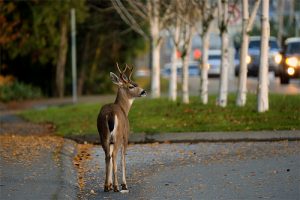 Even if you haven’t struck a deer with your vehicle, chances are good that you know someone who has. The reasons for this common type of accident are many: habitat fragmentation, the movements of deer during mating season, and the location of highways. But there are a few steps you can take to reduce the risk of running into a deer in the first place.
Even if you haven’t struck a deer with your vehicle, chances are good that you know someone who has. The reasons for this common type of accident are many: habitat fragmentation, the movements of deer during mating season, and the location of highways. But there are a few steps you can take to reduce the risk of running into a deer in the first place.
Heed Warning Signs
Deer crossing signs are put up for good reason. Many of the highway systems in our country cut across prime deer habitat, including state and national forests. Be on the lookout for deer crossing signs to identify areas that are used heavily by the animals. Conversely, the absence of a deer crossing sign doesn’t mean that you shouldn’t be vigilant. These are adaptable animals that may move into urban and suburban areas to escape hunting or find new browsing, which means that you can encounter them just about anywhere.
Travel During the Day
It’s impossible for most of us to restrict our vehicle usage to only daylight hours. However, avoiding the road during the hours of dawn and dusk, when the light is murky and deer are most active, might just help you avoid a collision. The simple fact is that it’s much easier to see an obstacle in the road during daylight.
If you do have to travel during these times of the day, consider using your vehicle’s high beams to help spot any animals on the road. This will assist in giving you plenty of time and distance to stop. Your headlights might also reflect a deer’s eyes, which makes spotting it easier.
Look for More Deer
If you spot a deer in the road and manage to avoid a collision, you should be especially alert to the possibility that other deer may be about to follow the first. Deer tend to travel in herds, and it’s not uncommon to see multiple animals run across the highway, one-by-one. If you’ve come to a complete stop to avoid the first deer, carefully scan the sides of the road to determine that no more animals are on the verge of crossing before resuming your travels.
Don’t Swerve
When a collision is imminent, most experts recommend that you stay the course. You should apply your brakes to reduce your speed and, therefore, reduce the severity of impact, but you shouldn’t swerve to avoid the collision. If you swerve into another lane, you run the risk of colliding with another vehicle, which would almost certainly be worse than hitting the deer. You can also honk your horn. Some experts have suggested that the sound will startle deer out of their mesmerized state, allowing them to escape unharmed.
While sharing the road with deer is a fact of life in much of America, following these simple tips will help you keep the risk of accidents to a minimum. Above all, you should always remain alert and careful in any driving situation.
Photo by Marneejill | Licensed by CC BY-SA 2.0





